The Workhouse in Wales
Since the Acts of Union (1536-43), Wales has been administered under the same laws as England. Thus, the Poor Law Acts of 1597 and 1601, and all successive poor law legislation applied equally to England and Wales.
One Welsh county, the border county of Monmouthshire, has a peculiar status — after its name was omitted from the second Act of Union in 1543, the misguided notion arose that it was not truly part of Wales. Monmouthshire is thus often found listed in the English section of old directories, and administrative references to Wales often use the term 'Wales and Monmouthshire'.
Up to 1834
Prior to 1834, parishes in Wales predominantly dispensed poor relief as 'out-relief' (money, food, clothes, blankets, fuel) and relatively little use was made of 'indoor' relief through the establishment of a workhouse.
A parliamentary report of 1777 recorded parish workhouses then in operation in England and Wales. Of almost 2,000 entries, only twenty were in Wales, of which more than half were in Pembrokeshire. The Welsh entries are listed below grouped by county, with the number of inmates they could accommodate given in brackets:
| Carmarthenshire | Laugharne (6). |
| Denbighshire | Llansillin (40), Wrexham (70). |
| Glamorganshire | Cardiff—St John the Baptist and St Mary (200), Swansea Town (100). |
| Merionethshire | Llandderfel (8). |
| Montgomeryshire | Llanfyllin (10), Myfod (8). |
| Pembrokeshire | Begelly (3), Camrose (10), St Florence (5), Jefferston (5), Lampeter Velfrey (6), Lanunda (3), Lawrenny (10), Lyfurvrane (4), Manerbier (20), Mouncton (26), North Narberth (10). |
In 1782, Gilbert's Act provided for the setting up of workhouses only for the aged and infirm, and children. The following year, the parish of Llantrisant in Glamorgan resolved "that a Workhouse be established in or near the Town of Llantrissent for relief of the Poor of the said Parish of Llantrissent and setting the said Poor to work and so forth." Although clearly inspired by Gilbert's Act, the parish appears not to have formally adopted its provisions. The following May, sisters Mary and Rachel Frances were appointed as superintendents of the workhouse at salary of £10 a year. The able poor were required "to assist the Governess in keeping the Houses Clean makeing the Beds Brewing Bakeing & Boiling together with every other matter necessary to be done towards the health and Cleanliness of the said Poor & said Houses." (The able-bodied were not supposed to be admitted under Gilbert's Act and were subsequently expelled from the workhouse.)
In 1792, Montgomery, Pool, and thirteen other nearby parishes promoted a local Act of Parliament to establish the Montgomery and Pool Incorporation. The Incorporation, run by a 24-man board of directors, spent £12,000 on erecting a workhouse or 'House of Industry'. The workhouse could accommodate up to 1,000 inmates making it one of the largest in the largest in the country at that time.
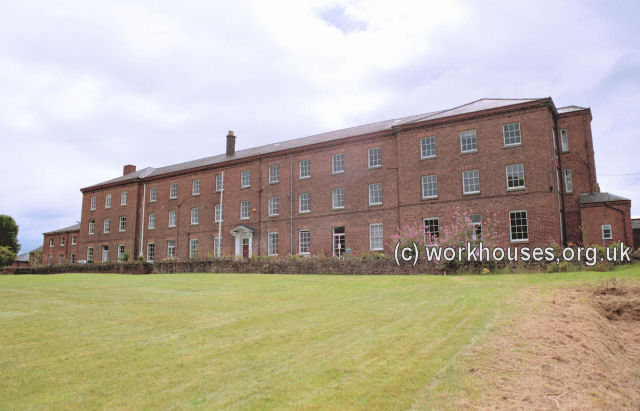
Montgomery and Pool Incorporation workhouse.
© Peter Higginbotham.
A further parliamentary survey in 1815 found that 59 Welsh parishes were now 'maintaining the greater part of their poor' in workhouses. (Since several parishes could share a workhouse, the number of workhouses in operation could be somewhat less than this figure.)
In the spring of 1836, Assistant Poor Law Commissioner George Clive visited the southern part of Wales and catalogued a multitude of malpractices and poor conditions.
Further, when an obstinate case of able-bodied pauperism does arise, the inability of the parish to deal with it appears most conspicuously. In the parish of Bettus, observing a sum of nearly 20l. paid for a great many years to one individual, the overseer, in answer to my questions, said, that this man was healthy and able, but somehow or other had always contrived to impose on the magistrates ; that at last the parish in despair had, by a promise of 40l., prevailed on him to emigrate with his wife and three children ; however, when just about to step into the vessel, he refused to go unless the parish officers would permit a prostitute of his acquaintance to accompany him ; this they did of course by another bribe; not satisfied, however, he still refused to go unless they gave him 6l. pocket-money ; this also they did, and then lived in constant dread of his return.
Many workhouses are rented in the county of Monmouth; in the parishes now forming the Monmouth Union, nearly 150l. is annually paid in rent for them, exclusive of course of cottages rented for the poor. In only one or two of these houses is there any attempt at a dietary or employment, in none classification, in the generality every kind of abuse. In Monythusloine poorhouse the contractor keeps a shop ; different families have apartments in the house; the whole is filthy to the last degree. In one room was a woman who has had nine bastard children, the last confessedly born in the house ; and from the time she had been resident there, doubtless many more.
The system is much the same in the Newport poorhouse, though no shop is kept ; the inmates going in and out for work or pleasure, the whole being enlivened by a lunatic in rags, who was running about where he pleased.
In Coleford poorhouse I found an idiot, who had been there 48 years ; during all this time, winter and summer, this poor wretch had had no other covering than a canvass shirt, no shoes even or stockings. At night he was, as the master expressed it, "ticed" or forced into an out-house, a place unfit even for an animal ; a hole in the wall was the only window; there he slept in some damp straw on the bare ground, for there was not even a stone floor. The answer to my remonstrances was, "He does not feel cold;" an assertion which the appearance of the shivering wretch sufficiently disproved. Yet in this very place did I receive remonstrances from some well-meaning, but more interested persons, against the cruelty of removing the poor to a well-conducted establishment at Monmouth.
Want of uniformity in management is also much felt : one parish is overburdened with paupers, while its next neighbour has scarcely any. The parish of Llangibby has the reputation of being kind to the poor, its rates are consequently very high, and the next parish, where the poor are treated with more strictness, is comparatively free from the burthen.
After 1834
The Poor Law Amendment Act of 1834 instituted a new administrative unit for poor relief — the Poor Law Union comprising a group of adjacent parishes. By the time of the Poor Law Commissioners' theirs annual report in 1838, all 47 new Welsh unions had officially come into existence. The only anomaly was the Montgomery and Pool Incorporation whose Local Act status made it immune from most of the provisions of the 1834 Act. It continued in operation until 1870 when it was forcibly dissolved and replaced by a new Forden Poor Law Union.
Despite the successful unionization of Wales, several areas, most notably the north-west, and the rural central region, resisted the introduction of the union workhouse required by the 1834 Act. Protests could be violent as happened in May 1937, when missiles were hurled at Assistant Poor Law Commissioner William Day. At Narberth, special constables were employed to protect the site after a mob attempted to burn down the new workhouse. Workhouses were also amongst the targets of the 'Rebecca Rioters' who, in 1842-43, carried out a campaign of protests across South Wales which included the storming of the Carmarthen workhouse on the 19th June, 1843.
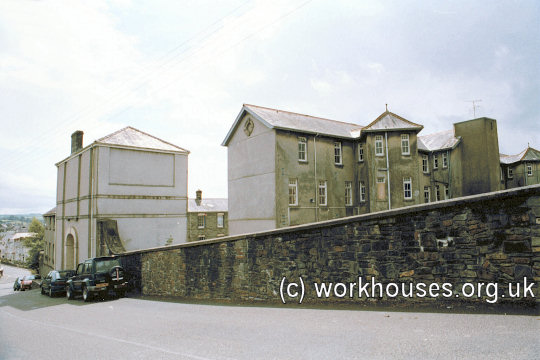
Carmarthen former workhouse.
© Peter Higginbotham.
The Rebecca Rioters took their name from the Book of Genesis (Chapter 24, Verse 60): "And they blessed Rebekah and said unto her, Thou art our sister, be thou the mother of thousands of millions, and let thy seed possess the gate of those which hate them." The rioters often included one or more 'Rebecca' figures dressed in women's clothes and wearing a wig of ringlets.
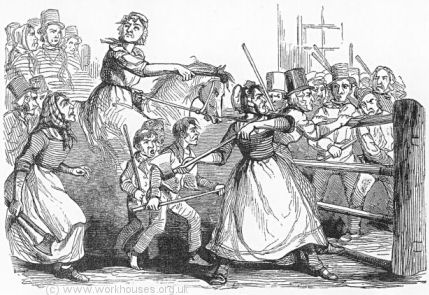
Rebecca rioters, 1843.
© Peter Higginbotham.
Sometimes, passive resistance was esed to thwart the Poor Law Commissioners, for example by Boards of Guardians endlessing deferring the discussion of a workhouse until their next meeting.
In 1845, the Poor Law Commissioners recorded 17 out of 47 Welsh unions as still 'not having efficient workhouses in operation'. This compared to 19 out of 544 English unions lacking operational workhouses at the same date. Steady pressure from the Commissioners, and their successors the Poor Law Board, gradually reduced this number but by the late 1860s, five unions in the centre of Wales (Builth, Lampeter, Presteigne, Rhayader and Tregaron) were still holding out, together with Crickhowell which was refusing to replace its ageing and inadequate former parish workhouse. Further pressure and threats resulted in compliance from Crickhowell (1870), Lampeter (1874), Builth (1875), and Tregaron (1876). The map below whows the pattern of delays between the formation of each union and the opening of its workhouse.
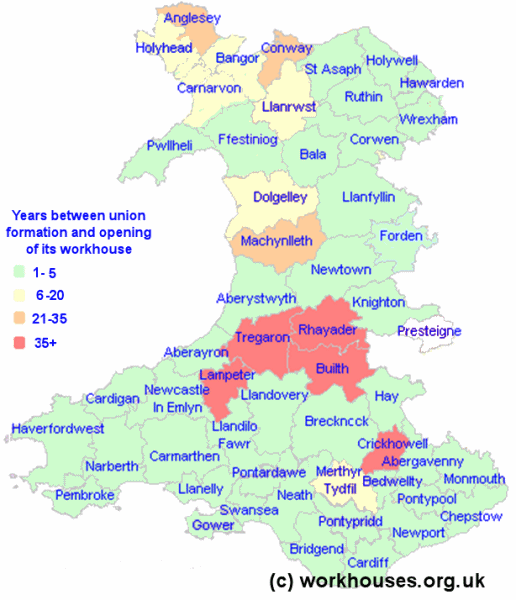
Delays in opening Union workhouses in Wales
© Peter Higginbotham.
Finally, the Local Government Board obtained new powers under The Divided Parishes and Poor Law Amendment Act, 1876 (39&40 Victoria c.61) which would let it dissolve any union "when it is expedient to do so for the purpose of rectifying or simplifying the areas of management, or otherwise for the better administration of relief...". In the face of this, Rhayader finally proceeded to build a workhouse. It received its first inmates in August 1879, making Rhayader the last union in the whole of England and Wales to open a workhouse complying with the requirements of the 1834 Act. Presteigne, however, stood its ground and was dissolved in 1877 with its constituent parishes being distributed to adjacent unions.
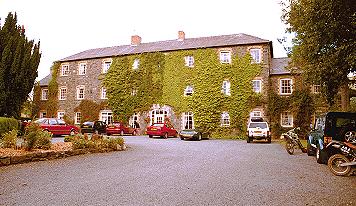
Rhayader workhouse — now a hotel
© Peter Higginbotham.
New Unions
In addition to the original 47 unions originally created in Wales, six additional ones were created. The majority of these were in the industrial south where the population in some existing unions grew unmanageably large — Bedwellty was formed in 1849 from the western part of the Abergavenny union; the Gower union was created in 1857 from part of Swansea union; Pontypridd was formed in 1863 from parts of the Cardiff and MerthyrTydfil unions; Pontardawe was formed in 1875 from part of the Neath union. In the north of Wales, a new Holyhead union was created in 1852 from the western part of the Anglesey union, and the following year Hawarden was formed from parishes in Flintshire and Cheshire.
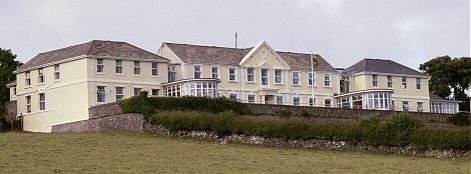
Gower workhouse — now a residential care home.
© Peter Higginbotham.
Workhouse Buildings in Wales
Since parish workhouses were so uncommon in Wales, almost all of the Welsh poor law unions had to erect new workhouse buildings rather than the usually cheaper option of adapting existing accommodation. The latter course was taken by Swansea, Monmouth and Crickhowell, although in each case a new purpose-built workhouse was eventually erected.
The Bala union appears to have been particularly unfortunate in that the workhouse it erected in 1839-41 was no longer satisfactory by 1875 and a replacement was built at a different site.
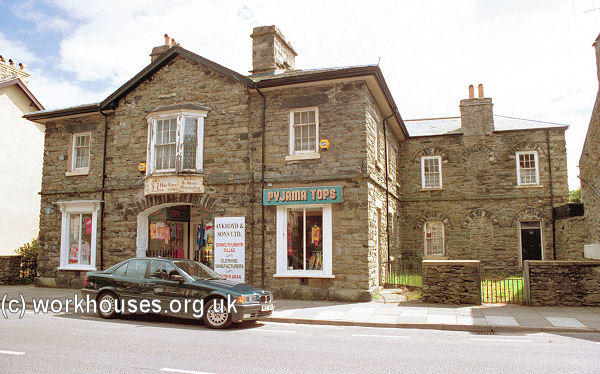
Bala's original High Street workhouse
© Peter Higginbotham.
Most of the new workhouses in Wales were designed by relatively local architects such as William Owen who designed the Narberth and Haverfordwest workhouses in Pembrokeshire. Of the major architects associated with the workhouse boom years of 1835-40 — Sampson Kempthorne, George Gilbert Scott and William Bonython Moffatt, and George Wilkinson — only Wilkinson undertook commissions in Wales. He was responsible for the workhouses at Aberayron, Abergavenny, Bridgend, and Pembroke — all of which survive, at least in part.
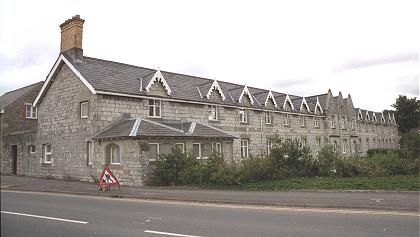
Bridgend & Cowbridge workhouse — now sheltered accommodation
© Peter Higginbotham.
Cottage Homes
Although it was often reluctant to countenance workhouses, Wales was a pioneer when it came to another type of Poor Law establishment known as 'cottage homes'. Cottage homes were intended to provided an alternative form of accommodation for children who would otherwise have been in the workhouse. The homes were usually located in 'villages' set in rural locations, and sometimes set around a 'green', where where 'families' of up to twenty children lived in a house under the care of a house 'mother'. Some of the first poor law cottage homes in Britain were established at Swansea in 1877, Neath in 1878, and Bridgend in 1879, with more than a hundred such sites eventually being established. As well as a houses and a school, the larger cottage home sites sometimes included workshops, an infirmary, chapel, and even a swimming pool.
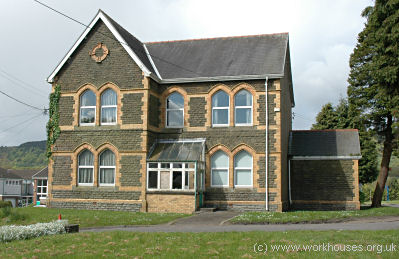
Early Cottage Homes at Neath.
© Peter Higginbotham.
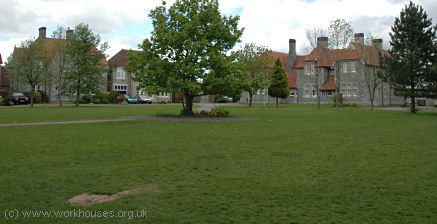
Bridgend cottage homes and green.
© Peter Higginbotham.
Industrial Strife and the Workhouse
In the 1870s, a fall in the price of coal and iron led to a recession with a reduction in workers' wages in South Wales industrial towns such as Merthyr Tydfil. A number of strikes resulted, the most significant of which began on January 1st 1875 after a 10% reduction in colliers' wages. The employers responded to this action with a lockout. The Merthyr Guardians, themselves mostly mine and iron-works owners, initially refused to offer any relief whatsoever to single men on strike. At the end of January able-bodied men were offered a "labour-test" — out-relief in return for performing a task of manual labour. The usual task to be employed was stone-breaking — large stones had to be broken to pieces that would fit through a 2¼-inch gauge grid, for which men were paid 1/- per cubic yard for limestone, or 1/4d per cubic yard for field or quarry stone. From February 19th, the Guardians decided that all single men should thenceforth only be relieved via admission to the workhouse. The situation escalated on 27th February when 900 single, able-bodied men converged on the workhouse demanding relief. The master admitted as many as there was room for, then turned away the rest. Those who had been admitted, tried to destroy workhouse discipline and four policemen were moved in to keep order. In mid-March, when the supply of suitable task work ran out, the Dowlais Iron Company offered colliery work as a substitute, which would have effectively broken the strike. The workers held out against this but, by May, they had been starved out and the strike collapsed.
A similar situation occurred in 1898 when wage-cuts by the employers resulted in another five-month-long strike. With the support of the Local Government Board, strikers were again offered an outdoor labour test. At the end of the dispute, colliery owners challenged the legality of providing such relief to strikers. In 1900, the Court of Appeal issued what became known as the Merthyr Tydfil judgment. It decreed that, regardless of his being on strike or not, an able-bodied man who could obtain work was not entitled to poor relief unless he was too exhausted by his situation to be capable of working. It was ruled, however, that the wives and families of strikers could claim poor relief. Unmarried strikers thus had no access to poor relief until they had become to debilitated to work.
Bibliography
- Grant, Raymond K (1988) On the Parish (Glamorgan Archive Service)
- Poor Relief in Merthyr Tydfil Union in Victorian Times by Tydfil Thomas (1992, Glamorgan Archive Service)
Unless otherwise indicated, this page () is copyright Peter Higginbotham. Contents may not be reproduced without permission.


